Lettuce, commonly featured in salads and sandwiches, is generally acknowledged as a nutritious component of meals. Nevertheless, for certain individuals, lettuce can become a cause of concern due to a lettuce allergy. This detailed guide will thoroughly examine the intricacies of lettuce allergies, covering aspects such as their causes, symptoms, diagnosis, and preventive measures.

Table of Contents
Understanding Lettuce Allergies
Lettuce allergies are genuine and can induce allergic responses in certain individuals. While a lettuce allergy may not be as prevalent as allergies to common foods like eggs or nuts, it still poses a significant risk to susceptible individuals. This allergy can manifest either as a food allergy or as contact dermatitis, both of which trigger immune system reactions upon ingestion or contact with this crisp vegetable.
How common is a lettuce allergy?

Lettuce allergies are exceptionally uncommon. Over the past three decades, the number of confirmed lettuce allergies is only a fraction of food allergies reported. The amount of lettuce allergy-related studies is also a good indicator of how uncommon this allergy really is. The number of studies on record is minimal, and most of these studies included no more than 25 participants.
To underscore the infrequency of lettuce allergies, I conducted a comparison of Google searches for “lettuce allergy,” “peanut allergy,” and “food allergy.” The findings suggest that “lettuce allergy” is not widely searched, possibly indicating its rarity.
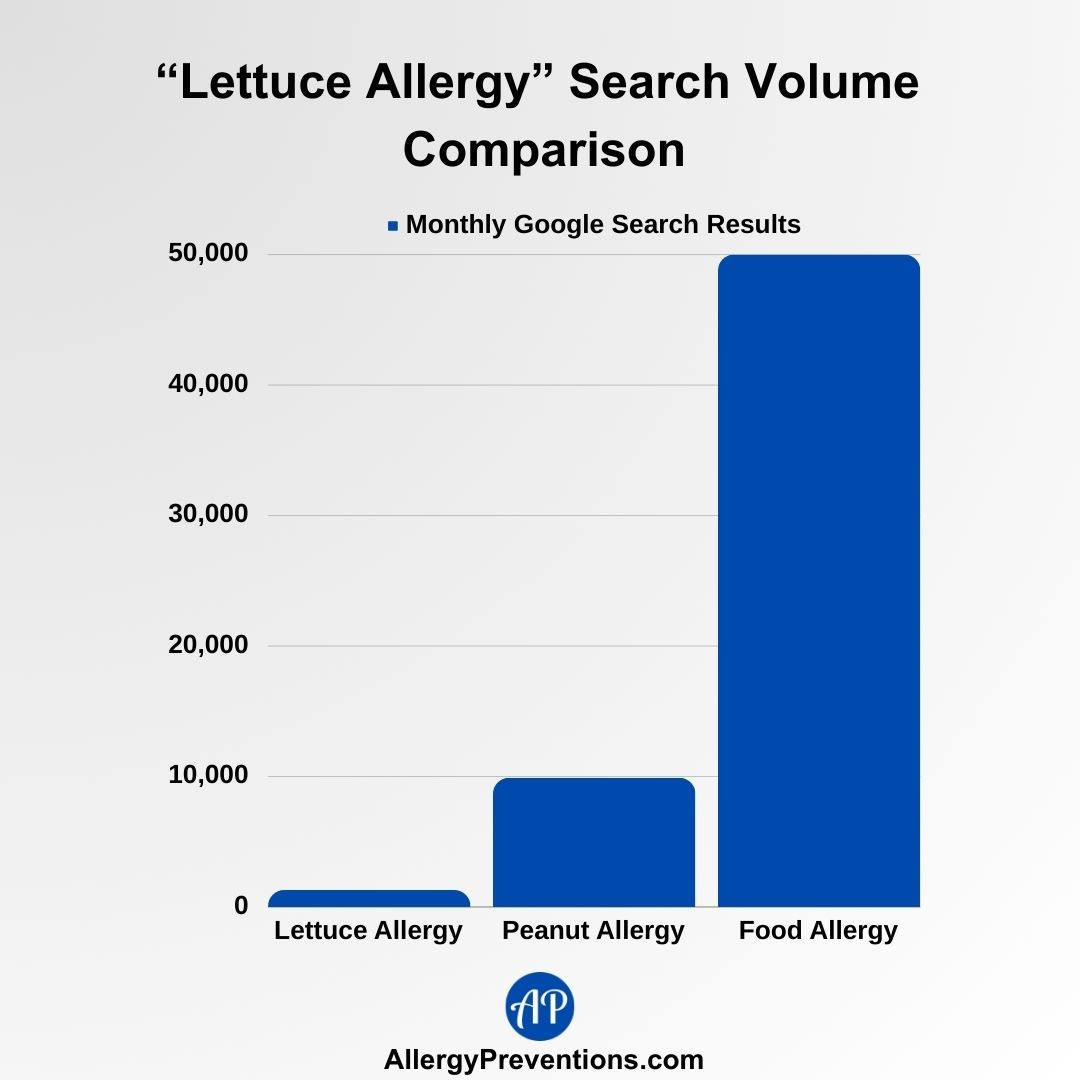
The phrase “Lettuce Allergy” is searched approximately 1300 times per month on Google, while “Peanut Allergy” sees around 9900 monthly searches, and “Food Allergy” gets a whopping 50,000 searches monthly.
Though lacking scientific validation, these figures suggest that peanut allergies are more than 600% more prevalent than lettuce allergies, and both combined barely touch the surface of food allergies as a whole.
What is in lettuce that makes you allergic?
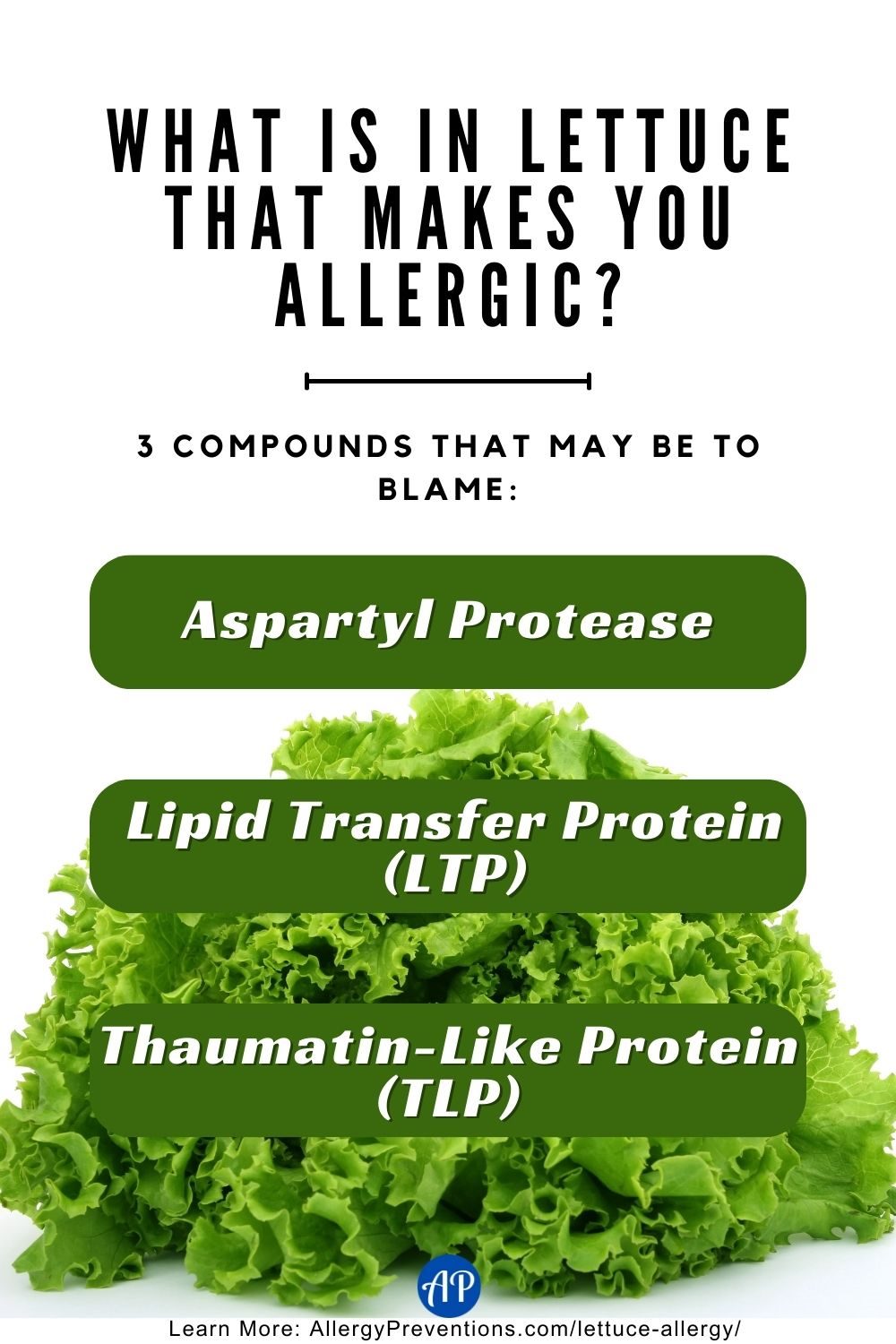
Lettuce contains compounds such as Lipid Transfer Proteins (LTPs), Thaumatin-Like Proteins (TLPs), and Aspartyl Protease, which can trigger allergic reactions. Sensitization to these compounds is linked to the development of food allergies, including allergies to lettuce.
Lettuce Allergy Causes
A lettuce allergy occurs when the immune system reacts to particular compounds found in lettuce, known as allergens. These allergens can prompt an immune response in certain individuals, resulting in allergic reactions. The primary contributors to lettuce allergy symptoms are likely to be one of the following compounds present in lettuce:
- Aspartyl Protease
- Lipid Transfer Protein (LTP)
- Thaumatin-Like Protein (TLP)
Aspartyl Protease
Aspartyl protease is an enzyme found in foods like lettuce, to break down proteins into smaller bits. Here are some common foods that typically contain the aspartyl protease enzyme:

- Avacado
- Beer
- Broccoli
- Brussel sprouts
- Cabbage
- Cheeses
- Kimchi
- Lettuce
- Miso
- Pickles
- Sausages/cured meats
- Sourdough bread
- Soy sauce
- Spinach
- Wine
- Yogurt
These examples represent only a portion of foods containing this enzyme, and the list is by no means exhaustive. The greatest concentrations of aspartyl protease are typically present in fermented and dairy products. Furthermore, the levels of this enzyme can be affected by various cooking and processing techniques.
Lipid Transfer Protein (LTP)
Lipid transfer proteins (LTPs) may cause allergy symptoms. These proteins play a role in transferring lipids (fats) between cell membranes and are found in the skin and seeds of foods.
In the context of allergies, certain LTPs have been identified as potential allergens that can trigger allergic reactions in sensitive individuals. Foods that commonly contain LTPs include:
- Almonds
- Apples
- Asparagus
- Banana
- Barley
- Beetroot
- Bell peppers
- Blueberry
- Broccoli
- Cabbage
- Celery
- Cherries
- Corn
- Dried fruits
- Eggplant
- Fennel
- Fermented foods
- Figs
- Garlic
- Goji berry
- Grapes
- Grapefruit
- Green beans
- Hazelnuts
- Kiwi
- Lentils
- Lettuce
- Lemon
- Lupin
- Millet
- Mulberry
- Mustard seed
- Onion
- Orange
- Parsley
- Peach
- Pear
- Peas
- Plum
- Pomegranate
- Processed plant-based foods
- Raspberry
- Strawberry
- Sunflower seeds
- Tangerine
- Tomatoes
- Vinegar
- Walnuts
- Wheat
- Wine
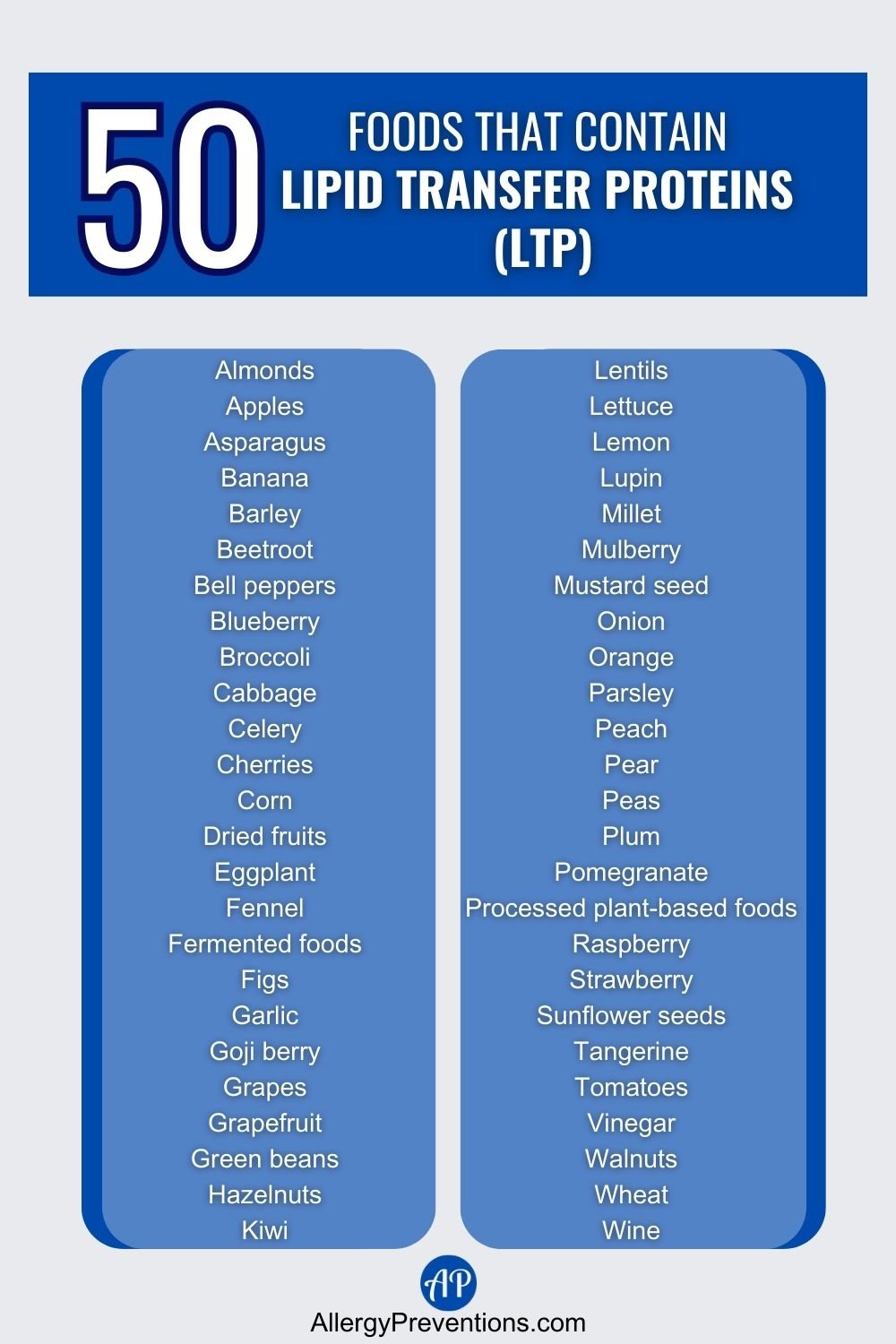
LTP Foods Fact: LTPs cannot be completely destroyed by processing (I.e. cooking, canning, fermenting). If the food contains LTPs, you cannot remove the LTPs.
This list doesn’t encompass all foods with Lipid Transfer Proteins (LTPs); it’s merely a representative sample. The presence of LTPs in these items doesn’t imply that everyone will experience an allergic reaction.
Allergies vary among individuals, and if someone suspects an LTP allergy, it’s advisable to consult with a healthcare professional for accurate diagnosis and guidance.
Thaumatin-Like Protein (TLP)
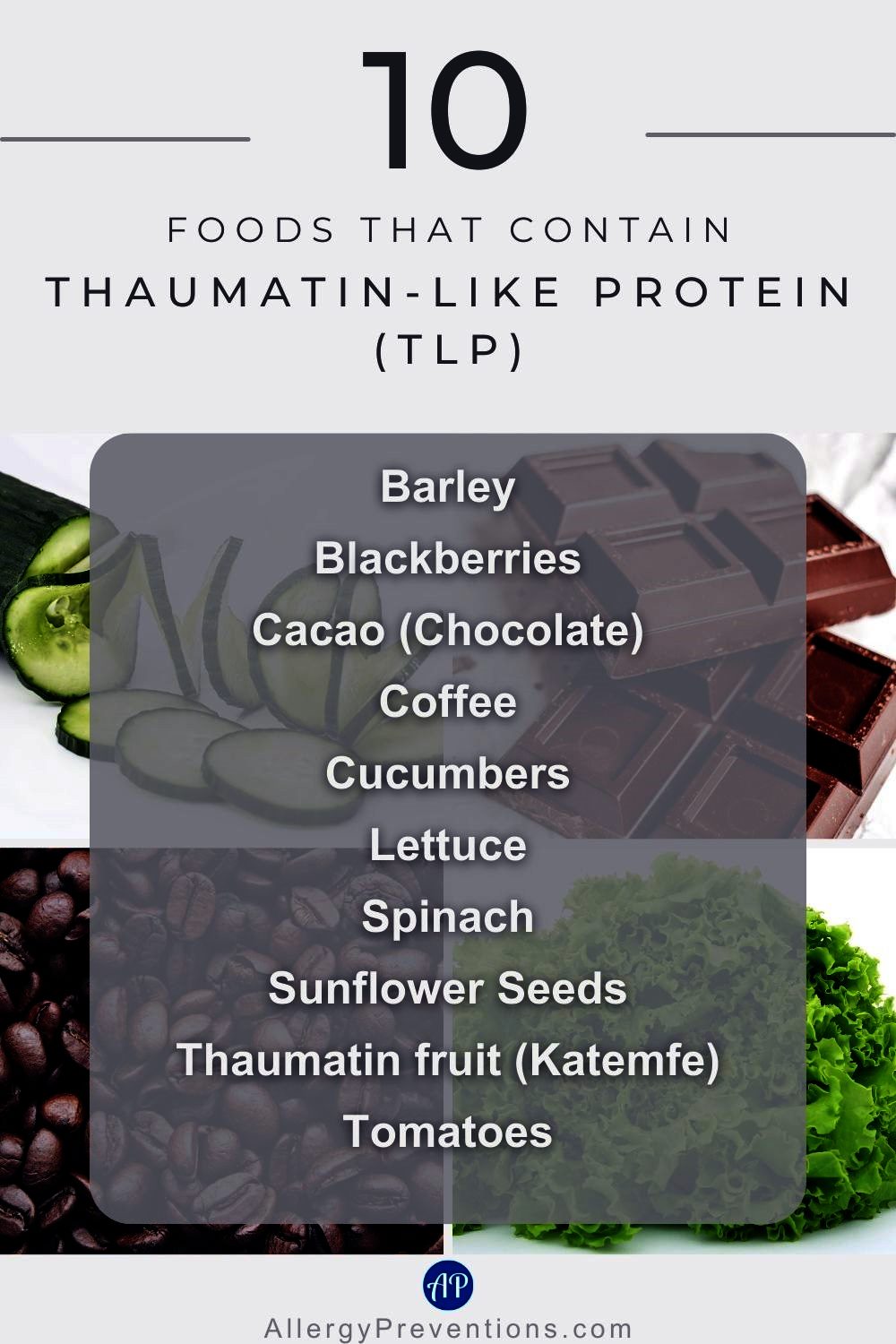
Thaumatin-like proteins (TLPs) constitute a group of naturally existing proteins present in a variety of foods, including lettuce, and are recognized for imparting a sweet taste to the food. The following are examples of foods known to contain thaumatin-like proteins:
- Barley
- Blackberries
- Cacao (Chocolate)
- Coffee
- Cucumbers
- Lettuce
- Spinach
- Sunflower Seeds
- Thaumatin fruit (Katemfe)
- Tomatoes
This list provides only a selection of commonly known foods containing Thaumatin-Like Proteins (TLPs). It’s crucial to acknowledge that the occurrence and concentration of thaumatin-like proteins can differ among various varieties and growth locations of the same food.
Risk Factors
The development of lettuce allergies, like many other allergies, can be influenced by a combination of genetic and environmental factors. This may include family history, dietary changes, and existing allergies. Let’s explore how these factors may contribute to the risk of developing lettuce allergies.
Genetic Factors

Genetic factors including inherited susceptibility, and genetic variations, can influence how the immune system identifies and reacts to substances. These reactions can potentially make you more susceptible to developing lettuce allergies.
Genetic Variations: Specific genetic variations or mutations can affect how the immune system responds to proteins in foods. Genetic variations can be passed down, and play a role in determining how the immune system identifies and reacts to substances.
Inherited Susceptibility: Individuals with a family history of allergies, including food allergies, may have a genetic predisposition to allergic conditions. If parents or close relatives have allergies, there may be an increased likelihood that their offspring could develop allergies, including lettuce allergies.
Environmental Factors

Environmental factors, including allergens, dietary modifications, and increased exposure to allergens, may elevate the susceptibility of specific individuals to the development of food allergies, including those associated with lettuce.
Understanding these environmental influences is crucial for assessing and managing the risk of food allergies in vulnerable individuals.
- Dietary changes: changes in dietary habits, including the consumption of processed or allergen-rich foods, can impact the development of food allergies.
- Delayed exposure: delayed exposure to allergenic foods as a child may increase the risk of developing allergies. Studies suggest that early exposure to primary allergenic foods can be more efficient in preventing the emergence of food allergies in children and adolescents.
- Environmental allergens: cross-reactivity between environmental allergens and proteins in lettuce could potentially increase the risk of lettuce allergies in susceptible individuals.
- Microbial exposure: according to the hygiene hypothesis, limited exposure to diverse microbes could lead to an immune system that reacts more intensely to specific substances, potentially initiating allergic responses to certain foods.
It’s crucial to emphasize that, although genetic factors and environmental elements can play a role in the likelihood of developing lettuce allergies, individual experiences vary. Not every individual with a genetic predisposition or exposure to specific environmental factors will necessarily develop allergies to lettuce.
Lettuce Allergy Symptoms
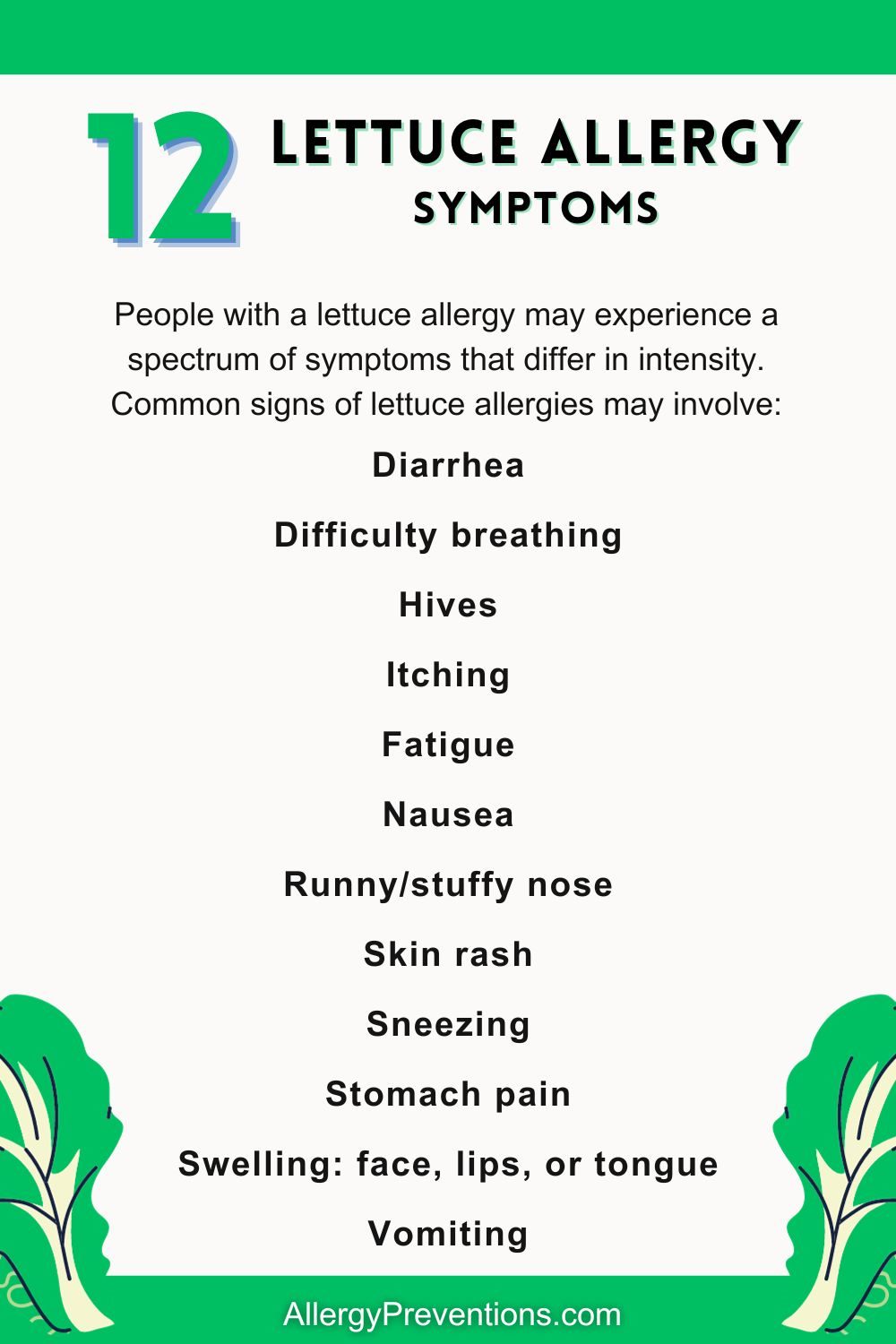
Individuals with a lettuce allergy, including romaine lettuce, may experience a range of symptoms that can vary in severity. Common signs of a lettuce allergy include itching, hives, stomach pain, and diarrhea. Additional symptoms may include:
- Diarrhea
- Difficulty breathing
- Hives
- Itching
- Fatigue
- Nausea
- Runny or stuffy nose
- Skin rash
- Sneezing
- Stomach pain
- Swelling: face, lips, or tongue
- Vomiting
These are the primary signs of a lettuce allergy, but there could be others too. People’s bodies react in various ways, and allergies are no exception. Certain symptoms could be very serious and need quick medical care. If you think you might have a lettuce allergy or if your symptoms are severe, get medical help right away.
Diagnosis

Identifying a lettuce allergy involves a combination of medical history, physical examination, and specific allergy tests. Here are the standard steps in diagnosing a lettuce allergy:
- Blood tests: specific IgE antibody tests measure the levels of antibodies produced in response to lettuce allergens. Elevated levels may indicate an allergy.
- Elimination diet: this involves excluding lettuce and related foods from your diet for a specific period and then reintroducing them to observe any allergic reactions.
- Medical history: your doctor will inquire about your symptoms, their onset, and their frequency.
- Oral food challenge: under controlled conditions, your doctor may perform an oral food challenge. In a medical setting, you will consume gradually increasing amounts of lettuce to monitor for any allergic reactions.
- Physical examination: conducted to assess your overall health and look for physical signs of an allergic reaction, such as hives, swelling, or skin rashes.
Treatment
Treatment approaches for lettuce allergies differ depending on the severity of allergic reactions. While there is no cure for food allergies, various options exist to manage symptoms. The most prevalent treatments for lettuce allergies include avoidance, antihistamines, and, in severe cases, epinephrine.
- Avoidance: the primary and most effective strategy for managing a lettuce allergy is to refrain from consuming lettuce and any products containing it.
- Antihistamines: may provide relief for mild allergic symptoms such as itching, hives, or sneezing. The most suitable antihistamine for managing food allergies can vary among individuals and should be discussed with your doctor.
- Epinephrine: an auto-injector (EpiPen®), that is prescribed for emergency use in situations where a severe allergic reaction occurs.
Prevention

Preventing allergic reactions to lettuce necessitates being mindful, communicating effectively, and taking proactive measures to improve safety and comfort. Here are practical suggestions for reducing lettuce allergy symptoms:
- Avoid cross-reactive foods: steer clear of other leafy greens, vegetables, and certain herbs that may share allergenic components with lettuce.
- Check food labels: thoroughly read food labels to identify the presence of lettuce in various food products, even in unexpected ones.
- Communicate your allergies: clearly convey your lettuce allergy to friends, family, coworkers, and restaurant staff to prevent unintentional exposure.
- Have medication on hand: swift administration of allergy medication and/or epinephrine in the event of accidental exposure can be life-saving.
- Prevent cross-contamination: use separate cutting boards, knives, and utensils specifically designated for lettuce to avoid cross-contamination with other foods.
- Seek advice from a healthcare professional: consult with an allergist or healthcare expert to confirm the presence of a lettuce allergy and discuss personalized prevention strategies.
- Stay alert in social situations: whether at social events, parties, or potlucks, consistently inquire about the ingredients in dishes, as some individuals may not be aware of specific food allergies.
- Wear an allergen bracelet: utilize a medical alert bracelet indicating your lettuce allergy, especially in situations where verbal communication may be challenging.
FAQs
Having a lettuce allergy brings up a lot of questions, here are the most frequently asked questions as they relate to lettuce allergies.
How do you know if you are allergic to lettuce?
If your body experiences allergy-like reactions (e.g. itching, hives, digestive issues) after consuming lettuce, you might have an allergy and should be evaluated by a medical professional.
Can you be allergic to different types of lettuce?
Yes, it is possible to be allergic to multiple types of lettuce, including butterhead, iceberg, and romaine lettuce.
Can you be allergic to iceberg lettuce, but not romaine?
Yes, you can be allergic to iceberg lettuce, but not romaine lettuce. Different types of lettuce can contain distinct profiles of allergens, leading you to be allergic to one but not the other.
Why does lettuce upset my stomach?
Lettuce can upset your stomach for many different reasons including digestion issues, contamination, or even allergies. If you consistently experience stomach upset after consuming lettuce, consult with a healthcare professional.
Why does lettuce give me diarrhea?
Diarrhea from lettuce may be caused by food allergies or sensitivities, contamination, or digestive reasons. Contact your doctor to gain a better understanding of why lettuce may be causing you diarrhea.
Summary
Lettuce allergies, though uncommon, can pose challenges for individuals experiencing allergic reactions to this seemingly harmless vegetable. There are three compounds in lettuce that could trigger an allergic reaction, lipid transfer proteins, thaumatin-like proteins, and aspartyl protease. If you suspect a lettuce allergy, seek professional medical advice to manage this condition effectively.

